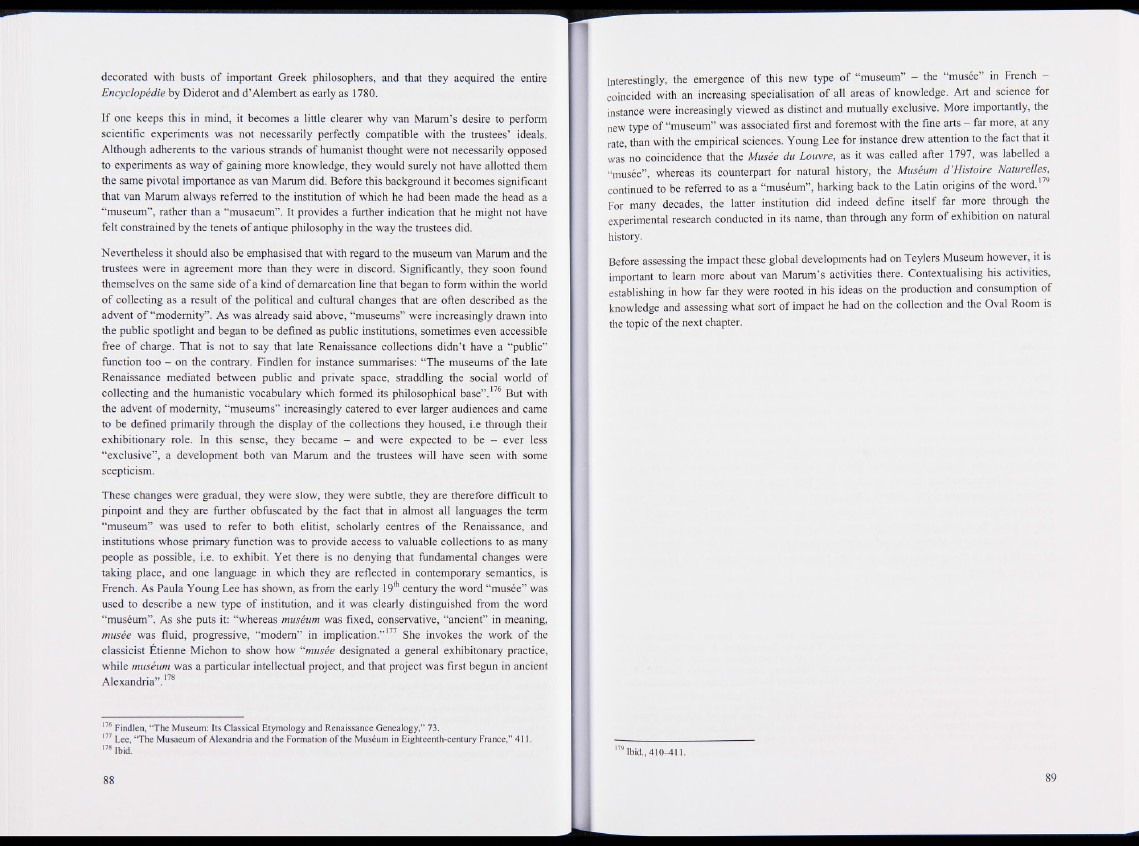
decorated with busts of important Greek philosophers, and that they acquired the entire
Encyclopédie by Diderot and d’Alembert as early as 1780.
If one keeps this in mind, it becomes a little clearer why van Marum’s desire to perform
scientific experiments was not necessarily perfectly compatible with the trustees’ ideals.
Although adherents to the various strands of humanist thought were not necessarily opposed
to experiments as way of gaining more knowledge, they would surely not have allotted them
the same pivotal importance as van Marum did. Before this background it becomes significant
that van Marum always referred to the institution of which he had been made the head as a
“museum”, rather than a “musaeum”. It provides a further indication that he might not have
felt constrained by the tenets of antique philosophy in the way the trustees did.
Nevertheless it should also be emphasised that with regard to the museum van Marum and the
trustees were in agreement more than they were in discord. Significantly, they soon found
themselves on the same side of a kind of demarcation line that began to form within the world
of collecting as a result of the political and cultural changes that are often described as the
advent of “modernity”. As was already said above, “museums” were increasingly drawn into
the public spotlight and began to be defined as public institutions, sometimes even accessible
free of charge. That is not to say that late Renaissance collections didn’t have a “public”
function too - on the contrary. Findlen for instance summarises: “The museums of the late
Renaissance mediated between public and private space, straddling the social world of
collecting and the humanistic vocabulary which formed its philosophical base”.176 But with
the advent of modernity, “museums” increasingly catered to ever larger audiences and came
to be defined primarily through the display of the collections they housed, i.e through their
exhibitionary role. In this sense, they became - and were expected to be SI ever less
“exclusive”, a development both van Marum and the trustees will have seen with some
scepticism.
These changes were gradual, they were slow, they were subtle, they are therefore difficult to
pinpoint and they are further obfuscated by the fact that in almost all languages the term
“museum” was used to refer to both elitist, scholarly centres of the Renaissance, and
institutions whose primary function was to provide access to valuable collections to as many
people as possible, i.e. to exhibit. Yet there is no denying that fundamental changes were
taking place, and one language in which they are reflected in contemporary semantics, is
French. As Paula Young Lee has shown, as from the early 19th century the word “musée” was
used to describe a new type of institution, and it was clearly distinguished from the word
“muséum”. As she puts it: “whereas muséum was fixed, conservative, “ancient” in meaning,
musée was fluid, progressive, “modem” in implication.” 177 She invokes the work of the
classicist Étienne Michon to show how “musée designated a general exhibitonary practice,
while muséum was a particular intellectual project, and that project was first begun in ancient
Alexandria”.178
176 Findlen, ‘T h e Museum: Its Classical Etymology and Renaissance Genealogy,” 73.
177 Lee, ‘The Musaeum o f Alexandria and the Formation o f the Muséum in Eighteenth-century France,” 411.
178 Ibid.
Interestingly, the emergence of this new type of “museum” — the musée in French —
coincided with an increasing specialisation of all areas of knowledge. Art and science for
instance were increasingly viewed as distinct and mutually exclusive. More importantly, the
new type of “museum” was associated first and foremost with the fine arts - far more, at any
rate, than with the empirical sciences. Young Lee for instance drew attention to the fact that it
was no coincidence that the Musée du Louvre, as it was called after 1797, was labelled a
“musée”, whereas its counterpart for natural history, the Muséum d ’Histoire Naturelles,
continued to be referred to as a “muséum”, harking back to the Latin origins of the word.
For many decades, the latter institution did indeed define itself far more through the
experimental research conducted in its name, than through any form of exhibition on natural
history.
Before assessing the impact these global developments had on Teylers Museum however, it is
important to learn more about van Marum’s activities there. Contextualising his activities,
establishing in how far they were rooted in his ideas on the production and consumption of
knowledge and assessing what sort of impact he had on the collection and the Oval Room is
the topic of the next chapter.
179 Ibid., 410-411.